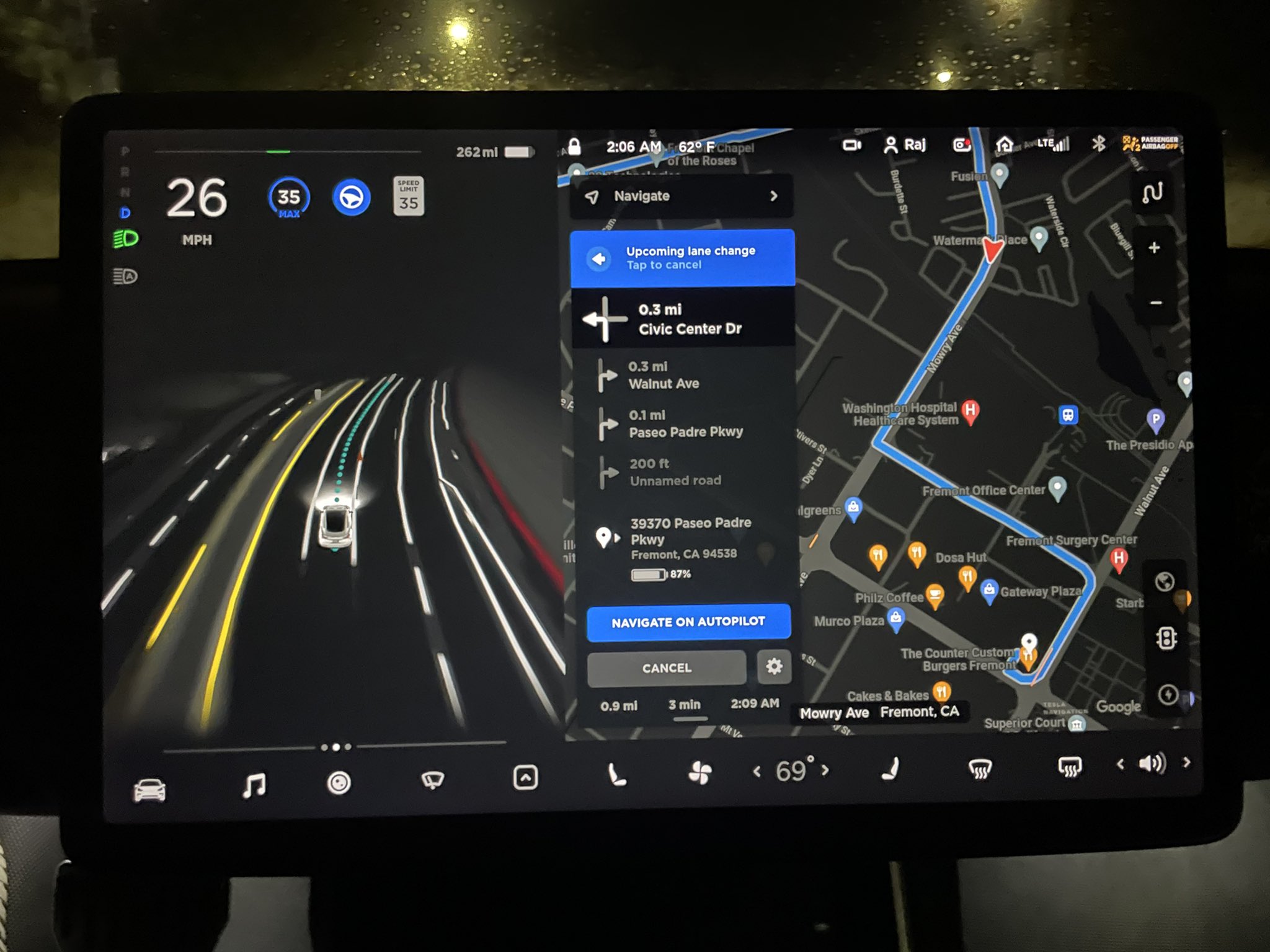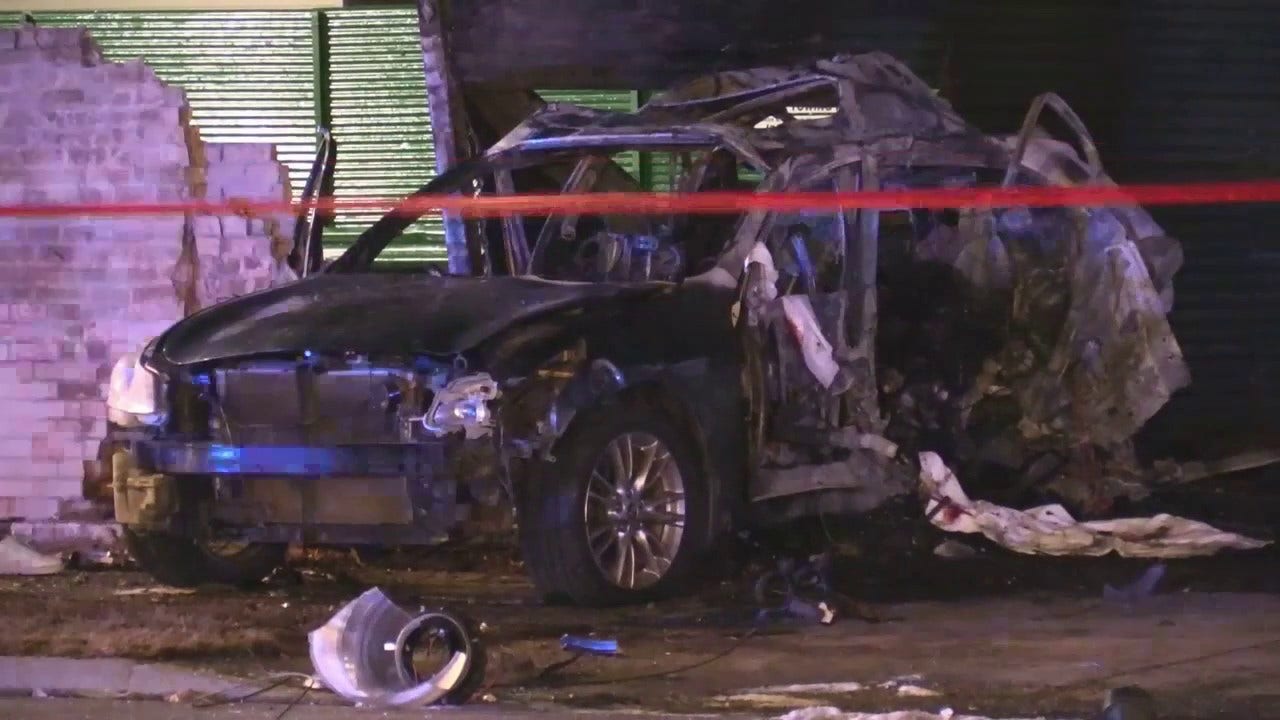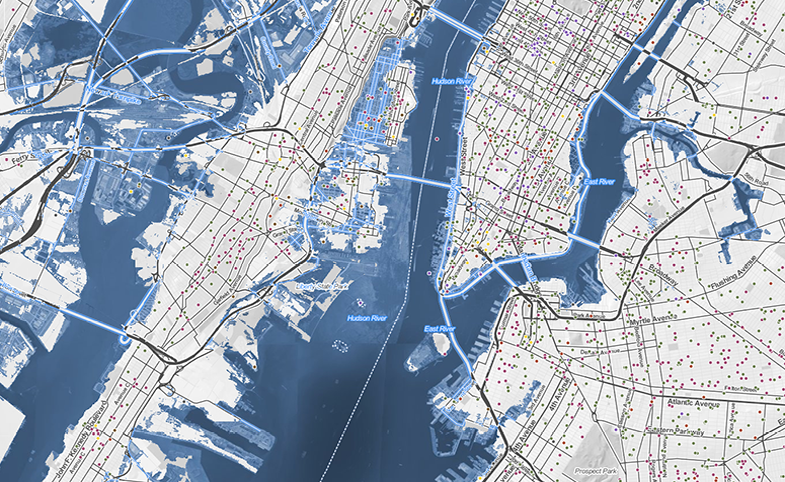Throwback to when it was supposedly to monitor Robotaxi users and ensure they don’t trash the vehicle, the cabin camera was never intended for eyeball tracking
Now here we are in 2023
Yeah, Elon makes mistakes. He is actually human.
You can install our site as a web app on your iOS device by utilizing the Add to Home Screen feature in Safari. Please see this thread for more details on this.
Note: This feature may not be available in some browsers.
Throwback to when it was supposedly to monitor Robotaxi users and ensure they don’t trash the vehicle, the cabin camera was never intended for eyeball tracking
Now here we are in 2023
You really cannot depend upon many/most drivers to exercise the level of vigilance needed
There are still zero studies out there showing complacency with reliable driver assist on is more dangerous than manual driving EXCEPT the data Tesla provides, and the amount of total death and accidents from Tesla vehicles being much lower than the national average.This Teslarati article focuses upon a known flaw in the human system. Essentially, "familiarity breeds contempt" is a very real issue. Here, IIHS comments upon the problem of this tendency of people to become complacent when using automated driving aids.
You really cannot depend upon many/most drivers to exercise the level of vigilance needed as the march of 9s strives to reach a functional full autonomy. There will be those instances of tragedy, and uncounted instances of near tragedy, as the data is gathered to accomplish this worthy goal.
On the flip-side, there will still be many, many lives saved which will not be counted, simply because you don't tend to notice when a system is working well.

Tesla’s FSD Beta recall gets response from IIHS President
Harkey noted that drivers of partially automated cars have shown a tendency to treat their cars like they are fully autonomous.www.teslarati.com
Shift paddles could be mapped to accelerator curve profiles like Eco vs Sport vs Track.You know your corporate culture needs to change to be competitive margin wise if a single gear car still comes with shift paddles. You can make an argument for the need for every button in that car, except for the paddles..lol.

Since the paddles are only there for the driver’s vanity, maybe they should just be attached to a bolt on, after market noise maker that makes engine noises. As you click up and down with the paddles the noises shift to simulate the sounds of being in different gears.Are you saying the shift paddles can be used to put the car in eco/normal/sport mode? That would be another engineering fail as it confuses the driver.
EAP already requires few interventions. FSD Beta won't introduce any new features on highways but will hopefully handle more situations without driver input and act more human-like (in the positive sense).
Thanks for the disagree... Not. While I agree with most of your reply, based on the recent reports of the crevices and fractures growing rapidly and somewhat unexpectedly, I believe we'll see a fairly large sea level rise in this decade. I found this article in the Scientific American to be quite informative:I put a disagree here, not because the Thwaites risk is not real, but because the risk is not imminent hence Curt's western Florida solar-powered project will probably long outlast his presently young life.
Once the Thwaites ice shelf collapses there still will not be catastrophic sea rise since the present melting is under the ice shelf. The catastrophe follows the shelf collapse over time as the land borne ice rapidly moves to the sea, so the dual effects of new fresh water in the Antarctic ocean and rise of ground level in Antartica do definitely produce catastrophe worldwide, with this handy mapping device showing the consequences:

It is worthwhile to note that the consequences of such and event would decimate most of the world's most consequential cities. from New York, Washington and Miami to Shanghai, London, the Netherlands, Bangladesh, Kolkata and so much more.
All the TSLA considerations disappear, as does the planet as humans have known it.
'Doomsday' is obviously not alliterative. The real questions are: one, is there anything that can be done to stop that; two, what about Greenland?; three, what about the arctic regions and permafrost melting?; four; how can mankind stop destruction and simultaneously resuscitate the health of our planet?
On a pessimistic day I am convinced Elon Musk may well be the only really influential person who understands we are destroying our planet. Thus on slight less pessimistic days I HODL TSLA and and some others. Surely those will endure well beyond my lifetime. I rather doubt my nephews and nieces will live so well, if they survive. My spouse and I are the only ones who live in edifices above that zone of rise, and our second home is well below the future water level.
Of course all this will not effect any material change in human behavior until the catastrophe strikes.

I would love to hear the turbo blowout valve sound and nitrous while we are at it.Since the paddles are only there for the driver’s vanity, maybe they should just be attached to a bolt on, after market noise maker that makes engine noises. As you click up and down with the paddles the noises shift to simulate the sounds of being in different gears.
Every once in a while it could make a voice over “Oh mai you are a great driver”, “Great Shift there!”, or “Fahrvergnügen”
“…with less reliance on lanes…”FSD Beta v11.3 Release Notes
- Enabled FSD Beta on highway. This unifies the vision and planning stack on and off-highway and replaces the legacy highway stack, which is over four years old. The legacy highway stack still relies on several single-camera and single-frame networks, and was setup to handle simple lane-specific maneuvers. FSD Beta’s multi-camera video networks and next-gen planner, that allows for more complex agent interactions with less reliance on lanes, make way for adding more intelligent behaviors, smoother control and better decision making.
- Added voice drive-notes. After an intervention, you can now send Tesla an anonymous voice message describing your experience to help improve Autopilot.
- Expanded Automatic Emergency Braking (AEB) to handle vehicles that cross ego’s path. This includes cases where other vehicles run their red light or turn across ego’s path, stealing the right-of-way.
- Replay of previous collisions of this type suggests that 49% of the events would be mitigated by the new behavior. This improvement is now active in both manual driving and autopilot operation.
- Improved autopilot reaction time to red light runners and stop sign runners by 500ms, by increased reliance on object’s instantaneous kinematics along with trajectory estimates.
- Added a long-range highway lanes network to enable earlier response to blocked lanes and high curvature.
- Reduced goal pose prediction error for candidate trajectory neural network by 40% and reduced runtime by 3X. This was achieved by improving the dataset using heavier and more robust offline optimization, increasing the size of this improved dataset by 4X, and implementing a better architecture and feature space.
- Improved occupancy network detections by oversampling on 180K challenging videos including rain reflections, road debris, and high curvature.
- Improved recall for close-by cut-in cases by 20% by adding 40k autolabeled fleet clips of this scenario to the dataset. Also improved handling of cut-in cases by improved modeling of their motion into ego’s lane, leveraging the same for smoother lateral and longitudinal control for cut-in objects.
- Added “lane guidance module and perceptual loss to the Road Edges and Lines network, improving the absolute recall of lines by 6% and the absolute recall of road edges by 7%.
- Improved overall geometry and stability of lane predictions by updating the “lane guidance” module representation with information relevant to predicting crossing and oncoming lanes.
- Improved handling through high speed and high curvature scenarios by offsetting towards inner lane lines.
- Improved lane changes, including: earlier detection and handling for simultaneous lane changes, better gap selection when approaching deadlines, better integration between speed-based and nav-based lane change decisions and more differentiation between the FSD driving profiles with respect to speed lane changes.
- Improved longitudinal control response smoothness when following lead vehicles by better modeling the possible effect of lead vehicles’ brake lights on their future speed profiles.
- Improved detection of rare objects by 18% and reduced the depth error to large trucks by 9%, primarily from migrating to more densely supervised autolabeled datasets.
- Improved semantic detections for school busses by 12% and vehicles transitioning from stationary-to-driving by 15%. This was achieved by improving dataset label accuracy and increasing dataset size by 5%.
- Improved decision making at crosswalks by leveraging neural network based ego trajectory estimation in place of approximated kinematic models.
- Improved reliability and smoothness of merge control, by deprecating legacy merge region tasks in favor of merge topologies derived from vector lanes.
- Unlocked longer fleet telemetry clips (by up to 26%) by balancing compressed IPC buffers and optimized write scheduling across twin SOCs.

 electrek.co
electrek.co
There are still zero studies out there showing complacency with reliable driver assist on is more dangerous than manual driving EXCEPT the data Tesla provides, and the amount of total death and accidents from Tesla vehicles being much lower than the national average.
It's just a hypothesis being spout as facts, as if adas is ONLY safer if the person is paying attention vs the person is sleeping with it on. Currently the only hard data we have is that the person sleeping with autopilot on is actually SAFER than the same tired person without autopilot. Even if autopilot is more likely to put a person to sleep, we still don't see this uptick in deaths and accidents from Tesla vs the national average.
I think every article that makes national news about a Tesla needs to start with "with about 4 million Tesla's on the road, we should expect 1 fatality every 2 days if Tesla's safety is the national average". The fact that we get a news article once every few week or month is actually a testament at how safe they are even though people are sleeping/texting/watching a movie with driver assist on.
I’ve brought this 19 year old book to the forefront some time ago when these types of discussions come up:Yes, that first sentence of the second paragraph describes what I was going on about. Too many drivers take for granted the concept of personal responsibility rather than actively practice it. These drivers casually discount the risk because driving is something "they do all the time."
I consider this behavior as the autonomous vehicle parallel for "An idle mind is the devil's Play Station"
It is human nature to take the path of least resistance and a conscious effort is necessary to thwart this behavior. Otherwise, it leads to dozing off, or spending too much time fiddling with something that better grabs one's focus. Either way, not enough attention being paid to the road. Granted, there are plenty of us with enough self restraint to be highly vigilant in avoiding distractions, but there are too many cases of those who aren't, and they make the headlines.
In my experience with other road users there are a lot of them that could embrace a better understanding of physics, and apply this to improving their driving skills.
In other words, Sheet Happens?<snip>
In the process caca can and will occur.
SiIn other words, Sheet Happens?
Good points but the one significant advantage Tesla does have is they at least control the hardware and know what hardware is in every vehicle.Awesome!
But as the owner of a 2018 Model 3 with EAP, I wonder how much of this I will inherit?
More generally, somewhere within Tesla is a huge matrix 'spreadsheet' with vehicle hardware permutations on one side and software features on the other, as well as which v. of release has which features.
Sadly, I'm thinking Tesla is in the unfortunate situation of the legacy software providers compared to Cloud circa the 2010's. A huge benefit of Cloud software, among others, is that there is only one (or at most very few) active version. This minimizes testing and support. There were several releases of Microsoft Word 2010, each running in a variety of versions and patches of Microsoft Windows, most of which Microsoft couldn't force users to upgrade. Therefore, there were literally hundreds (thousands?) of hardware + software combinations that, ideally, Microsoft had to test. That's where Tesla is today, and their code has to accommodate that. e.g., "okay we're approaching a red light, and this car has x cameras and y CPU and radar is (boolean) and the user has z features enabled, therefore I should do ___" (pseudo-code). Maybe the case of Salesforce is a better example since they did decimate SAP and Oracle in the CRM space, whereas Microsoft Office has been able to migrate to the Cloud pretty well (although I continue to believe Google does it better with the Cloud-native Workspace). I digress.
The only silver lining is that Tesla can and does upgrade their software at least, and sometimes even their hardware, limiting permutations and functional gaps. It doesn't have to plead with users to upgrade Windows 98 anymore and make their support job easier. But as long as we're in 'the hardware business' and don't auto-upgrade everybody in old Teslas, we won't really have "one AutoPilot to rule them all". Not the end of the world, just the facts.
We've had a lot of layoffs in the past 6 months. I'm not sure if the impact of that has hit the economy fully yet.I know today is not a trading day, but I've noticed since the sell off of TSLA there is a lot less posting in this thread. I feel like it must have shaken the paper hands out of this stock till we get back to 300+ and they buy in again. It's made it much easier to consume to be honest.
On an unrelated note, I am still full invested, but I can't help but shake the notion we are going to test the lows at some point. I know the upcoming product line and enhancements makes this irrational, but it just feels like this is a fake out. TSLA is still one of the largest retail holdings which gives me faith in the abilities of people/americans to read through the BS and see the product themselves. It's going to take a hell of a financial earthquake to get institutional investment to 80%. I am not much of a believer in things, but Tesla has solidified my view that when smart people find a worthy cause we can move the needle very quickly.


